Effective Note-Taking: Methods and Importance for Student Learning
VerifiedAdded on 2023/01/07
|7
|2014
|43
Report
AI Summary
This report delves into the critical role of note-taking in a student's academic journey. It highlights that note-taking enhances concentration and provides a permanent record for future review. The report outlines the three main stages of note-taking: before, during, and after class, providing practical strategies for each. Furthermore, it explores various note-taking methods, including the Cornell method, outlining, mapping, and charting, detailing their processes, benefits, and limitations. By incorporating these methods, students can improve their information retention, organization, and overall learning skills, leading to greater academic success. The report emphasizes the importance of active participation, critical thinking, and regular review to maximize the effectiveness of note-taking. The provided document is available on Desklib, a platform offering valuable study tools for students including past papers and solved assignments.
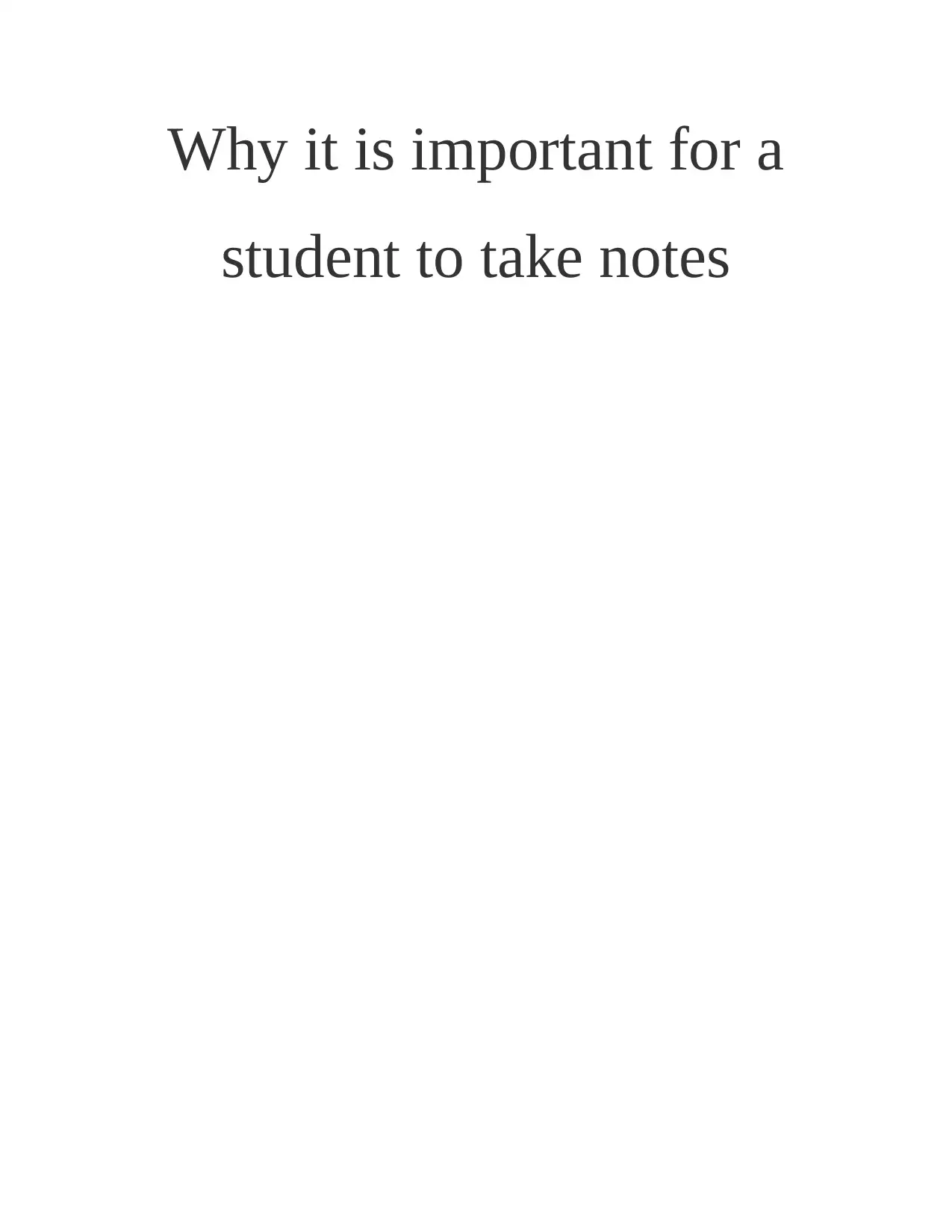
Why it is important for a
student to take notes
student to take notes
Paraphrase This Document
Need a fresh take? Get an instant paraphrase of this document with our AI Paraphraser
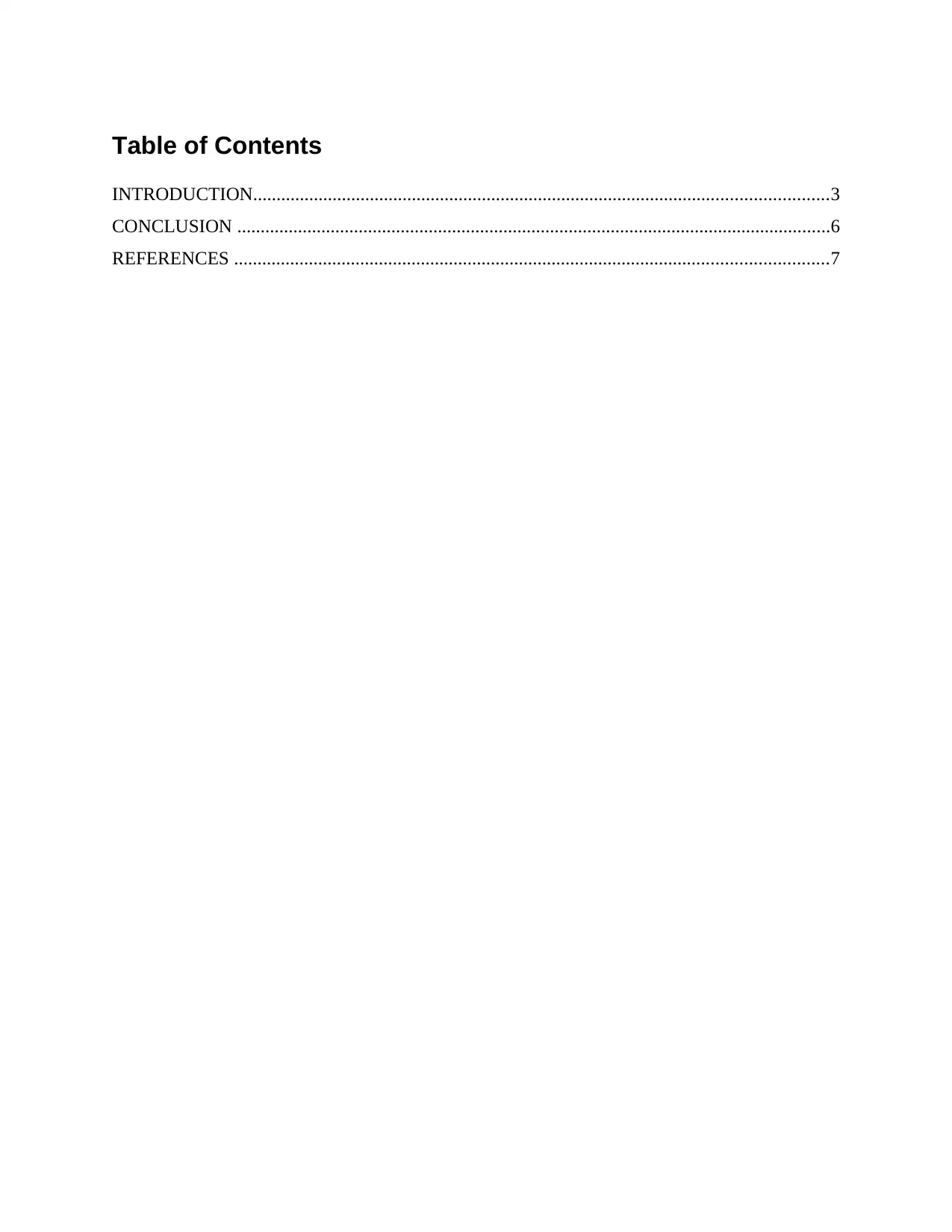
Table of Contents
INTRODUCTION...........................................................................................................................3
CONCLUSION ...............................................................................................................................6
REFERENCES ...............................................................................................................................7
INTRODUCTION...........................................................................................................................3
CONCLUSION ...............................................................................................................................6
REFERENCES ...............................................................................................................................7
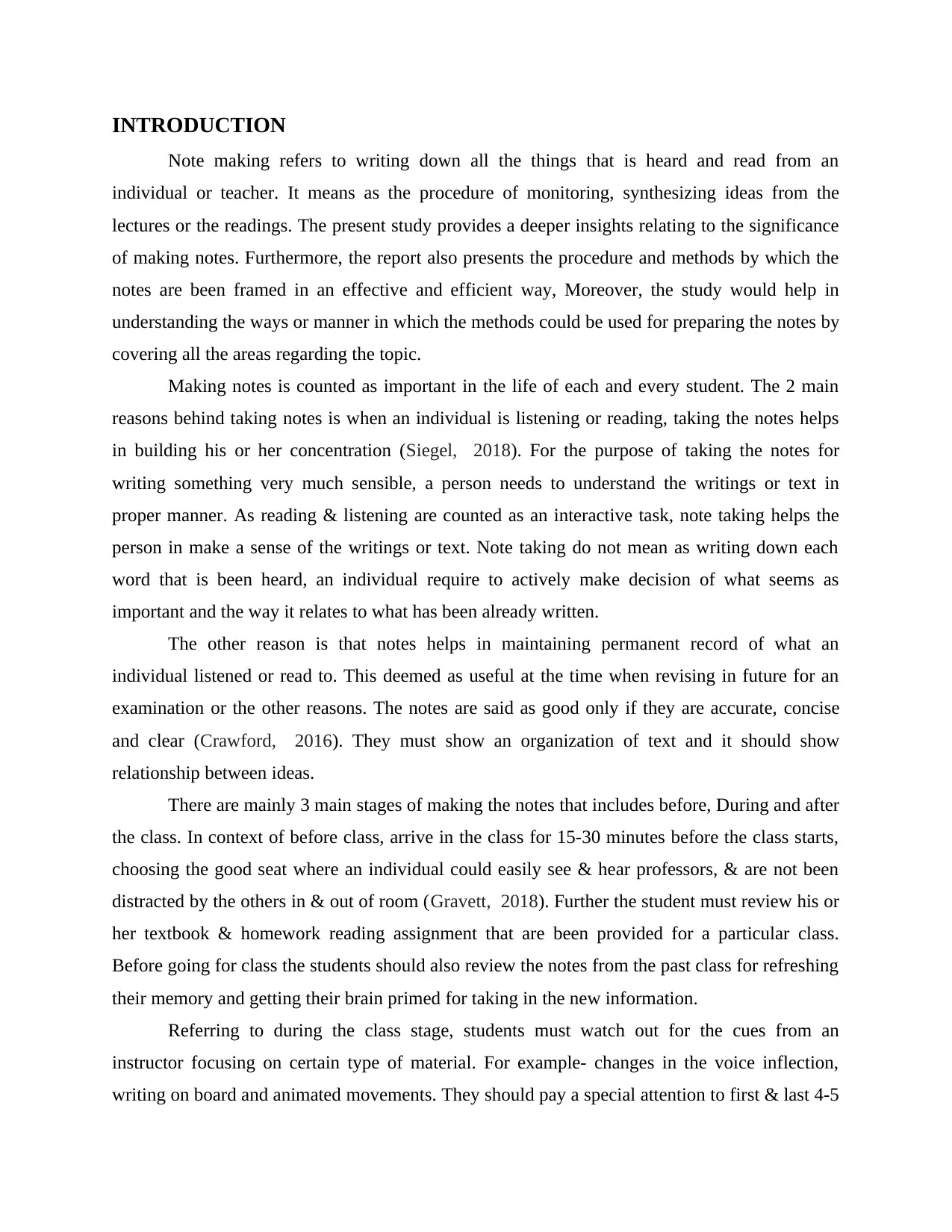
INTRODUCTION
Note making refers to writing down all the things that is heard and read from an
individual or teacher. It means as the procedure of monitoring, synthesizing ideas from the
lectures or the readings. The present study provides a deeper insights relating to the significance
of making notes. Furthermore, the report also presents the procedure and methods by which the
notes are been framed in an effective and efficient way, Moreover, the study would help in
understanding the ways or manner in which the methods could be used for preparing the notes by
covering all the areas regarding the topic.
Making notes is counted as important in the life of each and every student. The 2 main
reasons behind taking notes is when an individual is listening or reading, taking the notes helps
in building his or her concentration (Siegel, 2018). For the purpose of taking the notes for
writing something very much sensible, a person needs to understand the writings or text in
proper manner. As reading & listening are counted as an interactive task, note taking helps the
person in make a sense of the writings or text. Note taking do not mean as writing down each
word that is been heard, an individual require to actively make decision of what seems as
important and the way it relates to what has been already written.
The other reason is that notes helps in maintaining permanent record of what an
individual listened or read to. This deemed as useful at the time when revising in future for an
examination or the other reasons. The notes are said as good only if they are accurate, concise
and clear (Crawford, 2016). They must show an organization of text and it should show
relationship between ideas.
There are mainly 3 main stages of making the notes that includes before, During and after
the class. In context of before class, arrive in the class for 15-30 minutes before the class starts,
choosing the good seat where an individual could easily see & hear professors, & are not been
distracted by the others in & out of room (Gravett, 2018). Further the student must review his or
her textbook & homework reading assignment that are been provided for a particular class.
Before going for class the students should also review the notes from the past class for refreshing
their memory and getting their brain primed for taking in the new information.
Referring to during the class stage, students must watch out for the cues from an
instructor focusing on certain type of material. For example- changes in the voice inflection,
writing on board and animated movements. They should pay a special attention to first & last 4-5
Note making refers to writing down all the things that is heard and read from an
individual or teacher. It means as the procedure of monitoring, synthesizing ideas from the
lectures or the readings. The present study provides a deeper insights relating to the significance
of making notes. Furthermore, the report also presents the procedure and methods by which the
notes are been framed in an effective and efficient way, Moreover, the study would help in
understanding the ways or manner in which the methods could be used for preparing the notes by
covering all the areas regarding the topic.
Making notes is counted as important in the life of each and every student. The 2 main
reasons behind taking notes is when an individual is listening or reading, taking the notes helps
in building his or her concentration (Siegel, 2018). For the purpose of taking the notes for
writing something very much sensible, a person needs to understand the writings or text in
proper manner. As reading & listening are counted as an interactive task, note taking helps the
person in make a sense of the writings or text. Note taking do not mean as writing down each
word that is been heard, an individual require to actively make decision of what seems as
important and the way it relates to what has been already written.
The other reason is that notes helps in maintaining permanent record of what an
individual listened or read to. This deemed as useful at the time when revising in future for an
examination or the other reasons. The notes are said as good only if they are accurate, concise
and clear (Crawford, 2016). They must show an organization of text and it should show
relationship between ideas.
There are mainly 3 main stages of making the notes that includes before, During and after
the class. In context of before class, arrive in the class for 15-30 minutes before the class starts,
choosing the good seat where an individual could easily see & hear professors, & are not been
distracted by the others in & out of room (Gravett, 2018). Further the student must review his or
her textbook & homework reading assignment that are been provided for a particular class.
Before going for class the students should also review the notes from the past class for refreshing
their memory and getting their brain primed for taking in the new information.
Referring to during the class stage, students must watch out for the cues from an
instructor focusing on certain type of material. For example- changes in the voice inflection,
writing on board and animated movements. They should pay a special attention to first & last 4-5
⊘ This is a preview!⊘
Do you want full access?
Subscribe today to unlock all pages.

Trusted by 1+ million students worldwide
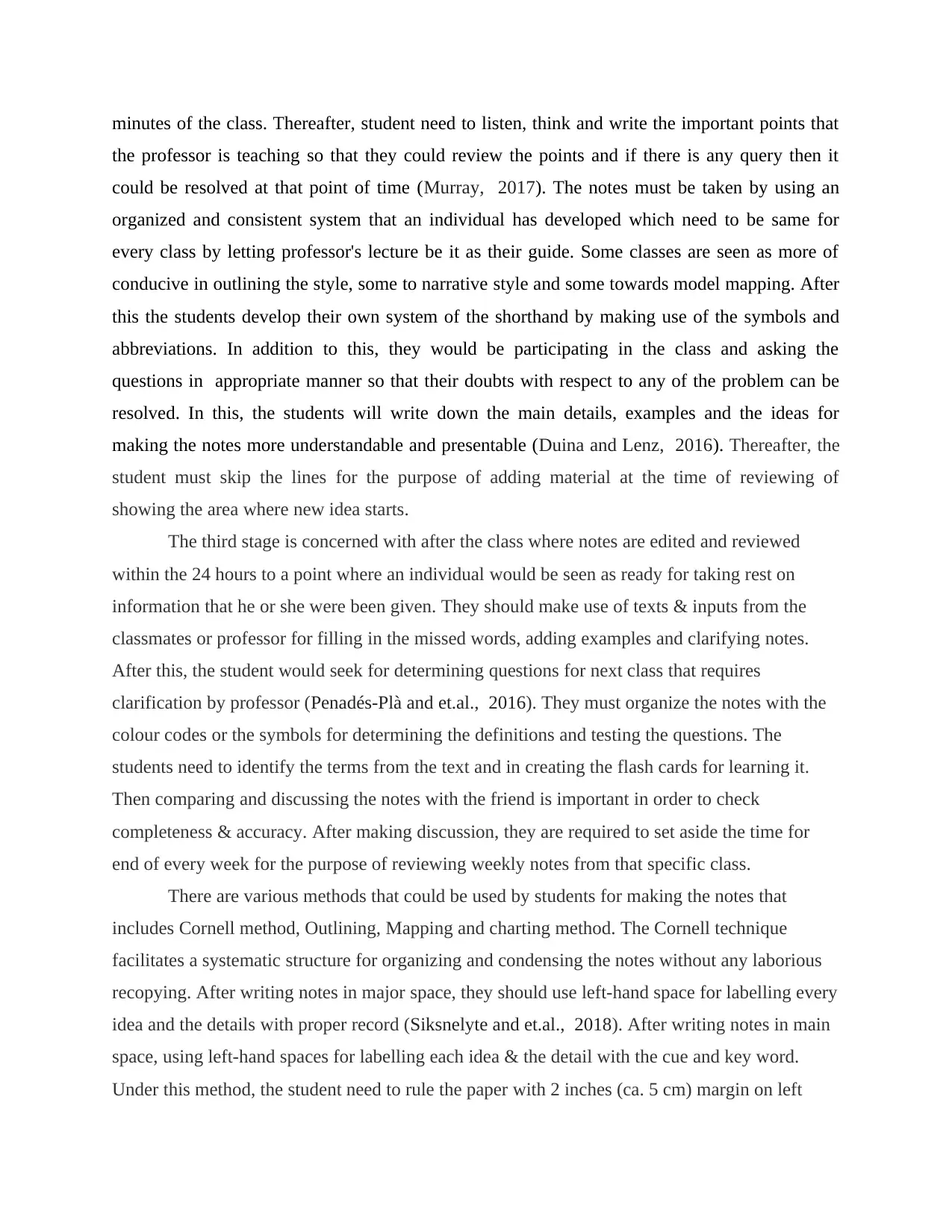
minutes of the class. Thereafter, student need to listen, think and write the important points that
the professor is teaching so that they could review the points and if there is any query then it
could be resolved at that point of time (Murray, 2017). The notes must be taken by using an
organized and consistent system that an individual has developed which need to be same for
every class by letting professor's lecture be it as their guide. Some classes are seen as more of
conducive in outlining the style, some to narrative style and some towards model mapping. After
this the students develop their own system of the shorthand by making use of the symbols and
abbreviations. In addition to this, they would be participating in the class and asking the
questions in appropriate manner so that their doubts with respect to any of the problem can be
resolved. In this, the students will write down the main details, examples and the ideas for
making the notes more understandable and presentable (Duina and Lenz, 2016). Thereafter, the
student must skip the lines for the purpose of adding material at the time of reviewing of
showing the area where new idea starts.
The third stage is concerned with after the class where notes are edited and reviewed
within the 24 hours to a point where an individual would be seen as ready for taking rest on
information that he or she were been given. They should make use of texts & inputs from the
classmates or professor for filling in the missed words, adding examples and clarifying notes.
After this, the student would seek for determining questions for next class that requires
clarification by professor (Penadés-Plà and et.al., 2016). They must organize the notes with the
colour codes or the symbols for determining the definitions and testing the questions. The
students need to identify the terms from the text and in creating the flash cards for learning it.
Then comparing and discussing the notes with the friend is important in order to check
completeness & accuracy. After making discussion, they are required to set aside the time for
end of every week for the purpose of reviewing weekly notes from that specific class.
There are various methods that could be used by students for making the notes that
includes Cornell method, Outlining, Mapping and charting method. The Cornell technique
facilitates a systematic structure for organizing and condensing the notes without any laborious
recopying. After writing notes in major space, they should use left-hand space for labelling every
idea and the details with proper record (Siksnelyte and et.al., 2018). After writing notes in main
space, using left-hand spaces for labelling each idea & the detail with the cue and key word.
Under this method, the student need to rule the paper with 2 inches (ca. 5 cm) margin on left
the professor is teaching so that they could review the points and if there is any query then it
could be resolved at that point of time (Murray, 2017). The notes must be taken by using an
organized and consistent system that an individual has developed which need to be same for
every class by letting professor's lecture be it as their guide. Some classes are seen as more of
conducive in outlining the style, some to narrative style and some towards model mapping. After
this the students develop their own system of the shorthand by making use of the symbols and
abbreviations. In addition to this, they would be participating in the class and asking the
questions in appropriate manner so that their doubts with respect to any of the problem can be
resolved. In this, the students will write down the main details, examples and the ideas for
making the notes more understandable and presentable (Duina and Lenz, 2016). Thereafter, the
student must skip the lines for the purpose of adding material at the time of reviewing of
showing the area where new idea starts.
The third stage is concerned with after the class where notes are edited and reviewed
within the 24 hours to a point where an individual would be seen as ready for taking rest on
information that he or she were been given. They should make use of texts & inputs from the
classmates or professor for filling in the missed words, adding examples and clarifying notes.
After this, the student would seek for determining questions for next class that requires
clarification by professor (Penadés-Plà and et.al., 2016). They must organize the notes with the
colour codes or the symbols for determining the definitions and testing the questions. The
students need to identify the terms from the text and in creating the flash cards for learning it.
Then comparing and discussing the notes with the friend is important in order to check
completeness & accuracy. After making discussion, they are required to set aside the time for
end of every week for the purpose of reviewing weekly notes from that specific class.
There are various methods that could be used by students for making the notes that
includes Cornell method, Outlining, Mapping and charting method. The Cornell technique
facilitates a systematic structure for organizing and condensing the notes without any laborious
recopying. After writing notes in major space, they should use left-hand space for labelling every
idea and the details with proper record (Siksnelyte and et.al., 2018). After writing notes in main
space, using left-hand spaces for labelling each idea & the detail with the cue and key word.
Under this method, the student need to rule the paper with 2 inches (ca. 5 cm) margin on left
Paraphrase This Document
Need a fresh take? Get an instant paraphrase of this document with our AI Paraphraser
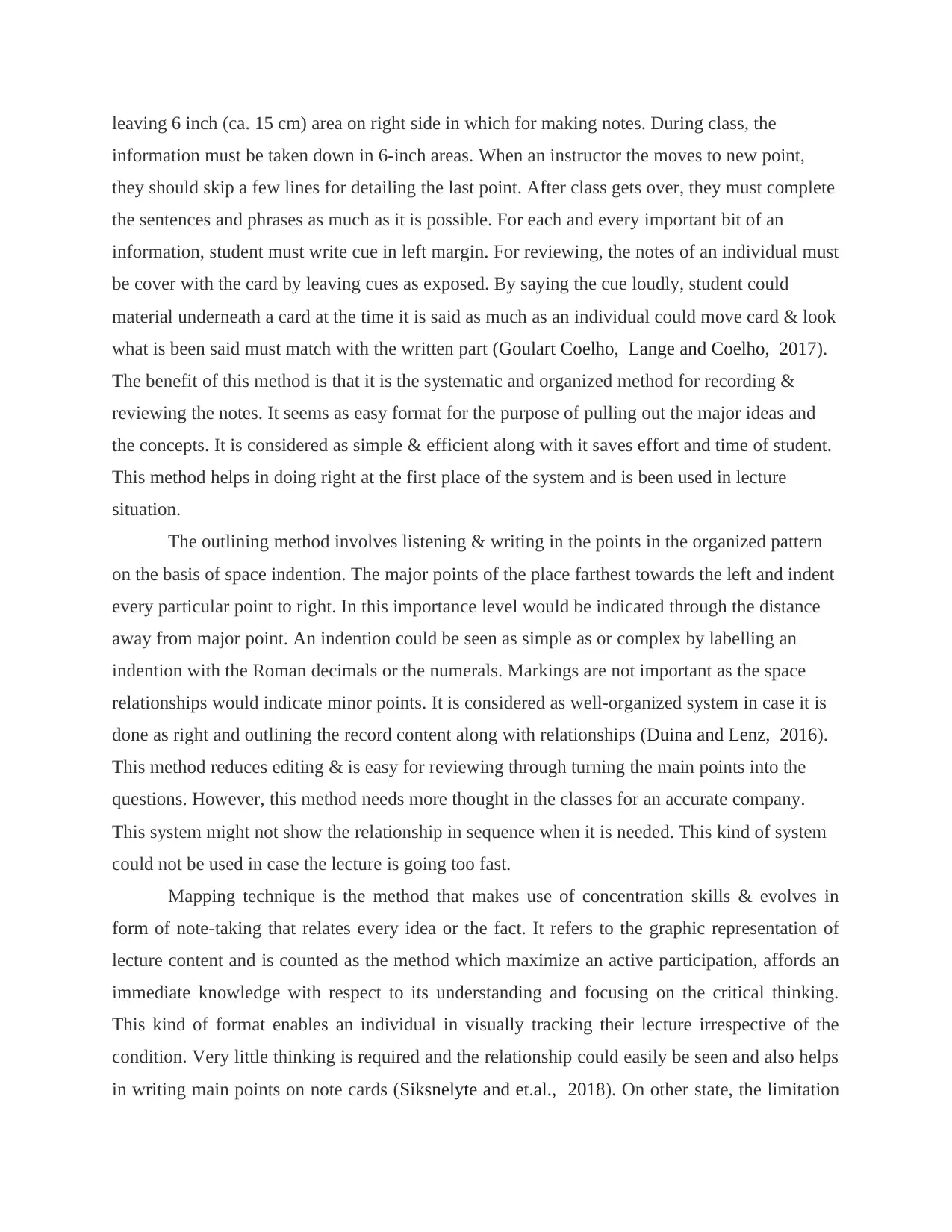
leaving 6 inch (ca. 15 cm) area on right side in which for making notes. During class, the
information must be taken down in 6-inch areas. When an instructor the moves to new point,
they should skip a few lines for detailing the last point. After class gets over, they must complete
the sentences and phrases as much as it is possible. For each and every important bit of an
information, student must write cue in left margin. For reviewing, the notes of an individual must
be cover with the card by leaving cues as exposed. By saying the cue loudly, student could
material underneath a card at the time it is said as much as an individual could move card & look
what is been said must match with the written part (Goulart Coelho, Lange and Coelho, 2017).
The benefit of this method is that it is the systematic and organized method for recording &
reviewing the notes. It seems as easy format for the purpose of pulling out the major ideas and
the concepts. It is considered as simple & efficient along with it saves effort and time of student.
This method helps in doing right at the first place of the system and is been used in lecture
situation.
The outlining method involves listening & writing in the points in the organized pattern
on the basis of space indention. The major points of the place farthest towards the left and indent
every particular point to right. In this importance level would be indicated through the distance
away from major point. An indention could be seen as simple as or complex by labelling an
indention with the Roman decimals or the numerals. Markings are not important as the space
relationships would indicate minor points. It is considered as well-organized system in case it is
done as right and outlining the record content along with relationships (Duina and Lenz, 2016).
This method reduces editing & is easy for reviewing through turning the main points into the
questions. However, this method needs more thought in the classes for an accurate company.
This system might not show the relationship in sequence when it is needed. This kind of system
could not be used in case the lecture is going too fast.
Mapping technique is the method that makes use of concentration skills & evolves in
form of note-taking that relates every idea or the fact. It refers to the graphic representation of
lecture content and is counted as the method which maximize an active participation, affords an
immediate knowledge with respect to its understanding and focusing on the critical thinking.
This kind of format enables an individual in visually tracking their lecture irrespective of the
condition. Very little thinking is required and the relationship could easily be seen and also helps
in writing main points on note cards (Siksnelyte and et.al., 2018). On other state, the limitation
information must be taken down in 6-inch areas. When an instructor the moves to new point,
they should skip a few lines for detailing the last point. After class gets over, they must complete
the sentences and phrases as much as it is possible. For each and every important bit of an
information, student must write cue in left margin. For reviewing, the notes of an individual must
be cover with the card by leaving cues as exposed. By saying the cue loudly, student could
material underneath a card at the time it is said as much as an individual could move card & look
what is been said must match with the written part (Goulart Coelho, Lange and Coelho, 2017).
The benefit of this method is that it is the systematic and organized method for recording &
reviewing the notes. It seems as easy format for the purpose of pulling out the major ideas and
the concepts. It is considered as simple & efficient along with it saves effort and time of student.
This method helps in doing right at the first place of the system and is been used in lecture
situation.
The outlining method involves listening & writing in the points in the organized pattern
on the basis of space indention. The major points of the place farthest towards the left and indent
every particular point to right. In this importance level would be indicated through the distance
away from major point. An indention could be seen as simple as or complex by labelling an
indention with the Roman decimals or the numerals. Markings are not important as the space
relationships would indicate minor points. It is considered as well-organized system in case it is
done as right and outlining the record content along with relationships (Duina and Lenz, 2016).
This method reduces editing & is easy for reviewing through turning the main points into the
questions. However, this method needs more thought in the classes for an accurate company.
This system might not show the relationship in sequence when it is needed. This kind of system
could not be used in case the lecture is going too fast.
Mapping technique is the method that makes use of concentration skills & evolves in
form of note-taking that relates every idea or the fact. It refers to the graphic representation of
lecture content and is counted as the method which maximize an active participation, affords an
immediate knowledge with respect to its understanding and focusing on the critical thinking.
This kind of format enables an individual in visually tracking their lecture irrespective of the
condition. Very little thinking is required and the relationship could easily be seen and also helps
in writing main points on note cards (Siksnelyte and et.al., 2018). On other state, the limitation
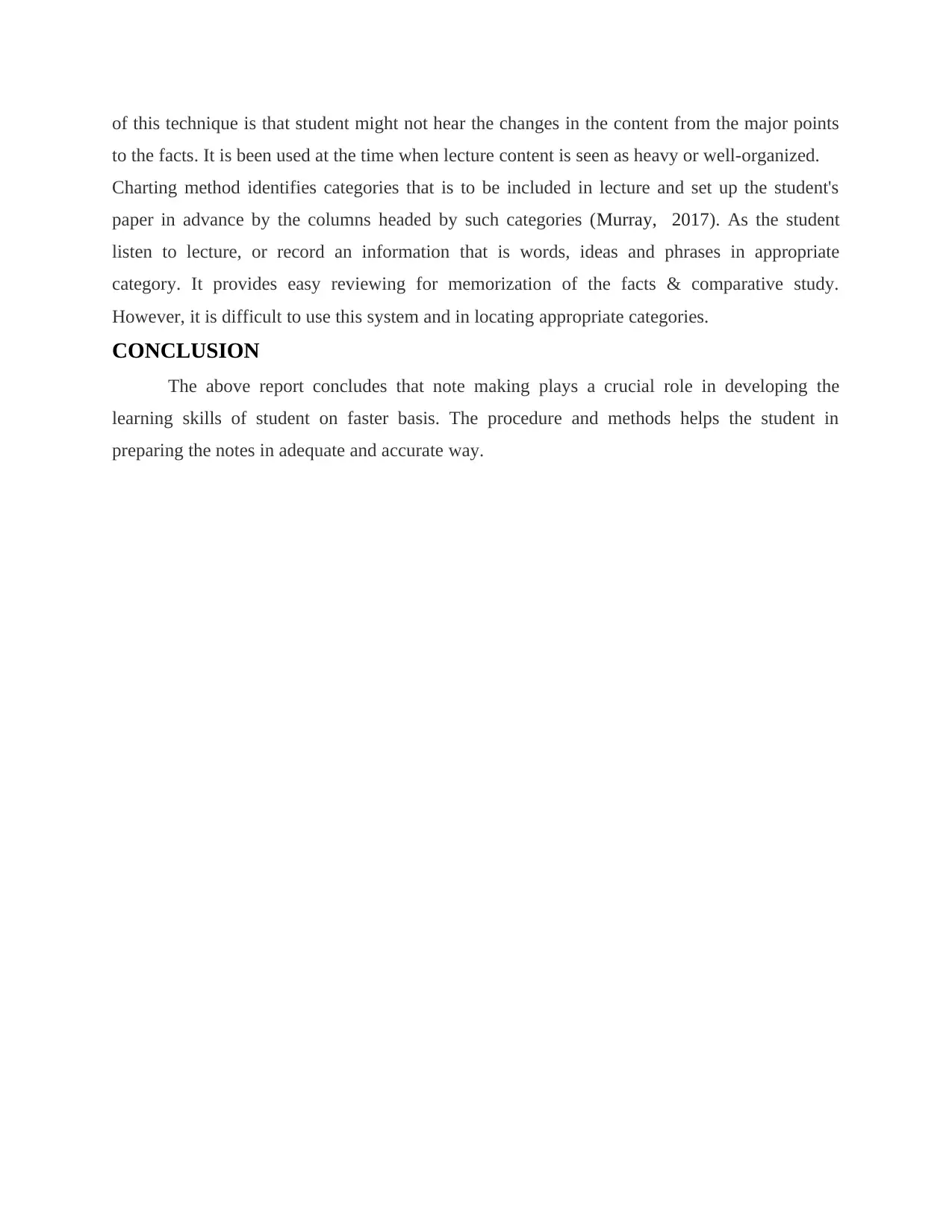
of this technique is that student might not hear the changes in the content from the major points
to the facts. It is been used at the time when lecture content is seen as heavy or well-organized.
Charting method identifies categories that is to be included in lecture and set up the student's
paper in advance by the columns headed by such categories (Murray, 2017). As the student
listen to lecture, or record an information that is words, ideas and phrases in appropriate
category. It provides easy reviewing for memorization of the facts & comparative study.
However, it is difficult to use this system and in locating appropriate categories.
CONCLUSION
The above report concludes that note making plays a crucial role in developing the
learning skills of student on faster basis. The procedure and methods helps the student in
preparing the notes in adequate and accurate way.
to the facts. It is been used at the time when lecture content is seen as heavy or well-organized.
Charting method identifies categories that is to be included in lecture and set up the student's
paper in advance by the columns headed by such categories (Murray, 2017). As the student
listen to lecture, or record an information that is words, ideas and phrases in appropriate
category. It provides easy reviewing for memorization of the facts & comparative study.
However, it is difficult to use this system and in locating appropriate categories.
CONCLUSION
The above report concludes that note making plays a crucial role in developing the
learning skills of student on faster basis. The procedure and methods helps the student in
preparing the notes in adequate and accurate way.
⊘ This is a preview!⊘
Do you want full access?
Subscribe today to unlock all pages.

Trusted by 1+ million students worldwide
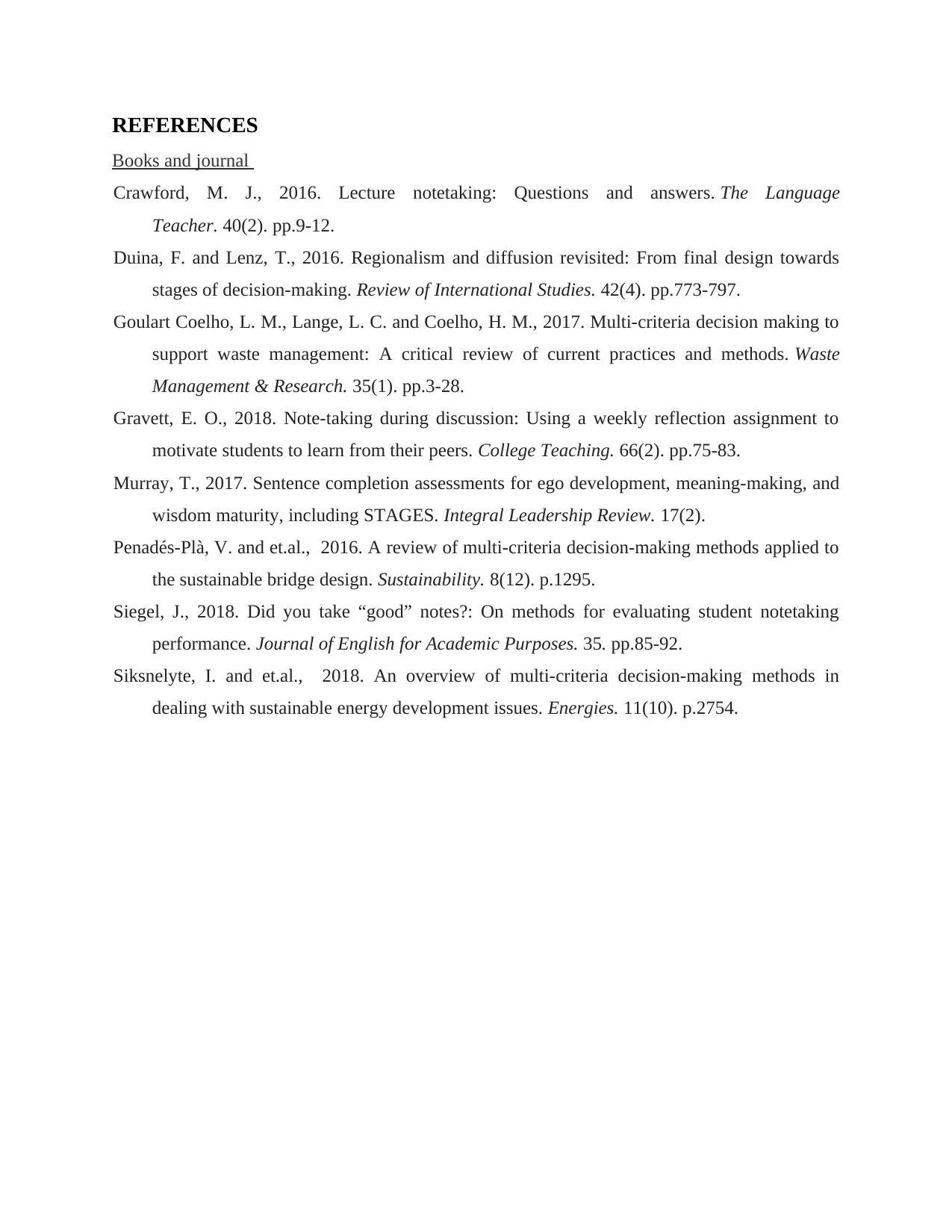
REFERENCES
Books and journal
Crawford, M. J., 2016. Lecture notetaking: Questions and answers. The Language
Teacher. 40(2). pp.9-12.
Duina, F. and Lenz, T., 2016. Regionalism and diffusion revisited: From final design towards
stages of decision-making. Review of International Studies. 42(4). pp.773-797.
Goulart Coelho, L. M., Lange, L. C. and Coelho, H. M., 2017. Multi-criteria decision making to
support waste management: A critical review of current practices and methods. Waste
Management & Research. 35(1). pp.3-28.
Gravett, E. O., 2018. Note-taking during discussion: Using a weekly reflection assignment to
motivate students to learn from their peers. College Teaching. 66(2). pp.75-83.
Murray, T., 2017. Sentence completion assessments for ego development, meaning-making, and
wisdom maturity, including STAGES. Integral Leadership Review. 17(2).
Penadés-Plà, V. and et.al., 2016. A review of multi-criteria decision-making methods applied to
the sustainable bridge design. Sustainability. 8(12). p.1295.
Siegel, J., 2018. Did you take “good” notes?: On methods for evaluating student notetaking
performance. Journal of English for Academic Purposes. 35. pp.85-92.
Siksnelyte, I. and et.al., 2018. An overview of multi-criteria decision-making methods in
dealing with sustainable energy development issues. Energies. 11(10). p.2754.
Books and journal
Crawford, M. J., 2016. Lecture notetaking: Questions and answers. The Language
Teacher. 40(2). pp.9-12.
Duina, F. and Lenz, T., 2016. Regionalism and diffusion revisited: From final design towards
stages of decision-making. Review of International Studies. 42(4). pp.773-797.
Goulart Coelho, L. M., Lange, L. C. and Coelho, H. M., 2017. Multi-criteria decision making to
support waste management: A critical review of current practices and methods. Waste
Management & Research. 35(1). pp.3-28.
Gravett, E. O., 2018. Note-taking during discussion: Using a weekly reflection assignment to
motivate students to learn from their peers. College Teaching. 66(2). pp.75-83.
Murray, T., 2017. Sentence completion assessments for ego development, meaning-making, and
wisdom maturity, including STAGES. Integral Leadership Review. 17(2).
Penadés-Plà, V. and et.al., 2016. A review of multi-criteria decision-making methods applied to
the sustainable bridge design. Sustainability. 8(12). p.1295.
Siegel, J., 2018. Did you take “good” notes?: On methods for evaluating student notetaking
performance. Journal of English for Academic Purposes. 35. pp.85-92.
Siksnelyte, I. and et.al., 2018. An overview of multi-criteria decision-making methods in
dealing with sustainable energy development issues. Energies. 11(10). p.2754.
1 out of 7
Related Documents
Your All-in-One AI-Powered Toolkit for Academic Success.
+13062052269
info@desklib.com
Available 24*7 on WhatsApp / Email
![[object Object]](/_next/static/media/star-bottom.7253800d.svg)
Unlock your academic potential
Copyright © 2020–2025 A2Z Services. All Rights Reserved. Developed and managed by ZUCOL.





